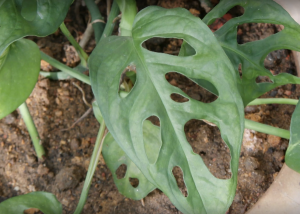Grow More of Your Favorite Plants Easily
 Have you ever wanted to have more of your favorite houseplants? With this technique, you can grow an abundance of plants. Soon you’ll have enough for new projects, to trade for new plants, or even give them away. Many plants can be grown from cuttings and Monstera obliqua is one of them. You can easily increase your plant collection with this method.
Have you ever wanted to have more of your favorite houseplants? With this technique, you can grow an abundance of plants. Soon you’ll have enough for new projects, to trade for new plants, or even give them away. Many plants can be grown from cuttings and Monstera obliqua is one of them. You can easily increase your plant collection with this method.
Monstera obliqua is an easy to keep plant who many find to be appealing for a houseplant. It is not a high maintenance plant, it grows easily, and this aroid freshens the air and atmosphere in any home. Who wouldn’t want another one, or dozens?
Many Plants Have Nodes Where a Leaf Grows Out of the Stem
The vining plant has a node on each runner where a leaf grows up. On this node is also a way for it to grow roots and establish itself in new positions. What we can do is take advantage of this growth habit to make us more plants easily. Each node where a leaf is exists the potential for a new plant.
The easiest method is to cut off the end section of one of the runners. This section that we cut off is considered an injury to the plant. There is no root system yet so the energy will have to come from the cutting itself. To increase the survivability, and to give it an extra advantage, we will cut a section off keeping 2 or 3 leaves as one cutting.
Use a Very Sharp Knife to Make Your Cuttings
Use a very sharp knife to cut the end of the runner off leaving 2 or 3 leaves in your cutting. Cutting the stem at an angle increases its ability to supply itself with water. The clean cut from a sharp makes the absolute most out of the surface space the cut has. Dull blades can crush the end of the stem, much like a chewed up drinking straw can obstruct the flow of juice from your cup.
Rooting hormones generally help most plants create new roots for a quicker start. Rooting hormone powder should be applied to the cut section of the stem according to the manufacturer’s label. Plants can be influenced by plant hormones to help grow roots faster. The rooting powder does this and helps force new roots faster in order to shorten the time the cutting must live off its own resources.
Once the plant cutting is dipped in the rooting powder it can be placed gently in a premoistened potting mix. Make a hole with a pencil or your finger and gently place the cutting with the rooting hormone down into the hole. Gently push the potting mix around the cuttings base to support it. We don’t want to water the plant the first day and wash off the plant hormone. This is why we pre-watered the potting mix. For the best results, the cutting should be placed in a shallow tray of water so it can wick up moisture so the powder doesn’t get rinsed off the cutting. Keep it out of hot direct sunlight and breezes to reduce moisture loss.
In a Few Weeks Your New Plant Will be Ready to Plant Out
In a few weeks, you should start seeing new growth coming from your plants. Any that have turned brown and crispy are not likely to make it and can be discarded. This method can also work very well with only one leaf node cutting. If it doesn’t survive try it with 2 or 3 leaves, and if you still have problems, give a 5 to 7 leave node cutting a try. The longer stem provides more energy for the plant to survive and grow roots.
This method is a great way to create new plants and it’s so easy to do. Soon you will have enough plants to create your own living green wall or simply trade for other species that you don’t yet have. Propagation is fun and rewarding. Give it a try and you might be surprised how green your thumb is.
 Biotope One A Study of Flora and Fauna
Biotope One A Study of Flora and Fauna 



